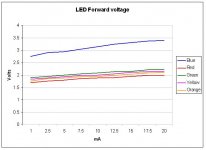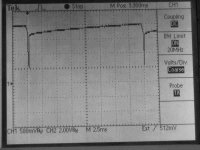I couldn't get clear charts of the LED forward voltage and so rigged up a simple plotter and measured it on a scope.
Might come in handy for some of you.
All LED's are normal 5 mm types . The blue LED is a 3mm type. All Taiwanese origin.
Cheers.
Might come in handy for some of you.
All LED's are normal 5 mm types . The blue LED is a 3mm type. All Taiwanese origin.
Cheers.
Attachments
Scope shot
Here is how the scope plot looked.
The source was a ramp voltage which controlled a current source connected to the LED. The voltage across the LED is measured on the scope. The ramp starts at 1 horizontal division and stops at 9 divisions. Each horizontal division is 2.5mA . So it goes from 0mA ( 1st div ) to 20 mA at 9div.
Vertical scale is as shown at the bottom of the screen.
( this LED is red ).
Note: For the vertical scale 0 V is not in the middle of the screen but at -1 div . Look for the pointer on the left of the screen.
Here is how the scope plot looked.
The source was a ramp voltage which controlled a current source connected to the LED. The voltage across the LED is measured on the scope. The ramp starts at 1 horizontal division and stops at 9 divisions. Each horizontal division is 2.5mA . So it goes from 0mA ( 1st div ) to 20 mA at 9div.
Vertical scale is as shown at the bottom of the screen.
( this LED is red ).
Note: For the vertical scale 0 V is not in the middle of the screen but at -1 div . Look for the pointer on the left of the screen.
Attachments
I've had a few very odd experiences with blue LEDs, I wonder if anyone else has too:
A 'dark blue' type, probably SiC, exhibited negative resistance characteristics. It would not light up until a treshold wvoltage was reached, but then would remain lit even at smaller voltages. In particular, it needed a 4k7 series resistor to light up, and be VERY bright, while increasing the resistance with the lit LED up to 47k would give decent brightness, but the LED would not light up if turned off and back on again.
A whole series of white LEDs showed marked differences in color depending on current - these were single crystal white high efficiency LEDs. At lower currents they would glow yellowish, then as current went up, bluish, then at some 10-20mA, the expected white color. Current vs voltage had 'steps' depending on the color rendering 'tresholds'.
A 'dark blue' type, probably SiC, exhibited negative resistance characteristics. It would not light up until a treshold wvoltage was reached, but then would remain lit even at smaller voltages. In particular, it needed a 4k7 series resistor to light up, and be VERY bright, while increasing the resistance with the lit LED up to 47k would give decent brightness, but the LED would not light up if turned off and back on again.
A whole series of white LEDs showed marked differences in color depending on current - these were single crystal white high efficiency LEDs. At lower currents they would glow yellowish, then as current went up, bluish, then at some 10-20mA, the expected white color. Current vs voltage had 'steps' depending on the color rendering 'tresholds'.
Have you tried this at differant temperatures and also a differant light levels?
I have in the pasy measured an output from a led when exposed to bright light!
regards Trev
I have in the pasy measured an output from a led when exposed to bright light!
regards Trev
there are a couple of different ways to do white LED's. one is to have yellow and blue junctions interspersed on a chip (or some white LED's seem to have the materials mixed together in the die when viewed under high magnification). another way is to use very short wavelength blue or even UV emitting die with a phosphor coating to change UV into white. the stepped voltage response is probably from yellow and blue interspersed junctions wired in parallel on the die. a stable single higher voltage drop, closer to 3.6V is probably a UV/phosphor type LED.
This will come in handy. . . Thank you, ashok! I subscribe to several
threads that will find this information useful.
threads that will find this information useful.
This will come in handy.....
I needed the info and couldn't find accurate measured information and was forced to build the jig to measure it .
I was sure that it would be very useful to many others and that's why I put it up.
Glad you find it useful.
Cheers.
- Status
- Not open for further replies.
- Home
- Amplifiers
- Solid State
- LED forward voltage plot

